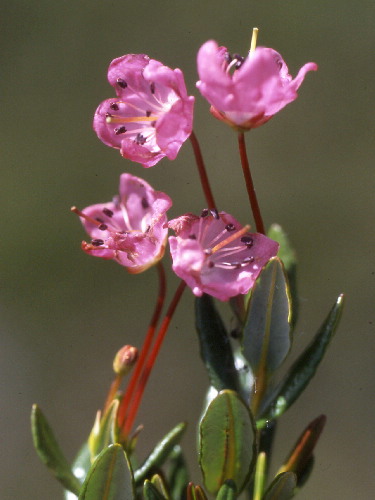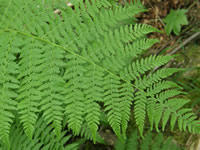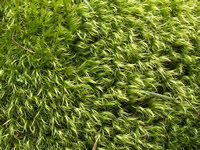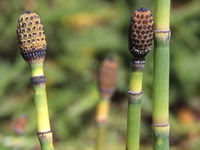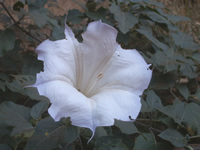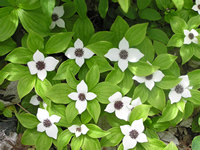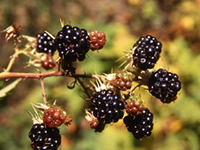| |
|
 |
Datura stramonium, has several common names which include Devil's Weed and Devil's Cucumber — names that suggest something bad! It is a leafy herb spreading across an area of up to six feet. |
|
| |
 |
The huge white flowers are trumpet shaped and face upwards, opening mainly at night. Most parts of the plant contain toxins and it has a history of causing delirious states and poisoning to those not familiar with this plant.
|
| |
|
The common shrubby plant, Spreading Dogbane, Apocynum androsaemifolium, enjoys the dry areas and is often found along roadsides and gravelled areas. The thin reddish stems grow to three feet with clusters of bell shaped flowers. When the stems are broken they produce a latex like milk which deters animals from feeding on the plant. |
| |
|
|
Western Bog Laurel, Kalmia microphylla spp. occidentalis, enjoys the higher elevations and boggy areas, flowering soon after the snows melt.
Having a similarity to Red Mountain Heather and growing amongst it, it can easily be missed if you are not looking closely for it.
The plant has caused poisoning in many animals with sheep being the most susceptible. This plant should be considered toxic throughout its entire range! |
__ |
|
| |
|
|
|
__ |
|
|
Showy Locoweed, Oxytropis splendens, here on the left and Yellow flowering Locoweed, Oxytropis monticola, are only two of the locoweeds throughout North America. There is a wide variety of colours in Locoweeds from purples to blue and yellow and whites. They are found in the foothills and semi arid areas. Locoweeds are poisonous at all stages of growth and dangerous at all times even when dried. All of the plant is toxic. |
| |
|
The Horse-chestnut tree, Aesculus hippocastanum, is a beautiful tree when in full flower. It is an introduced tree, brought to North American mainly because of its beauty and as a shade tree. Although beautiful, it has poisoned many animals, causing sickness and death. All parts of the tree, from the bark to the flowers, contain Esculin (also spelled: Aesculin) which is poisonous. |
| |
__ |
|
|
|
|
|
Western Bleeding-heart, Dicentra formosa, is a woodland flower of great beauty, hence the species name formosa, meaning beautiful. It's a plant native to North America, found in rich humus soils on the forest floor. The plant contains toxins including protopine along with other alkaloids. |
| |
|
European Nightshade, Solanum dulcamara, has a variety of common names including Poisonberry and Poisonflower besides other that have Nightshade added to it, a well-known name amongst poisonous plants. The fruit is a bright red and although birds find it edible, it is poisonous to humans and livestock. Its foliage is also poisonous. This introduction from Europe is a climbing, woody vine with clusters of purple and yellow flowers along its trailing and clinging branches. |
| |
| Red Elderberry, Sambucus racemosa, grows large bunches of fruits creating an amazing sight.
These berries are not palatable to humans and may be slightly poisonous.
Red Elderberry contains an alkaloid that can cause many sicknesses, nausea and vomiting. The stem contains small amounts, but the roots have been known to cause death to hogs. |
__ |
|
| |
|
|
Of course, this is just a quick overview of some of the various toxic plants you might come across during your walks in the woods. Indeed, the forests and meadows are truly full of incredible beautiful plants - all best just left alone to be admired exactly where they are! |
| |
|
|
|





